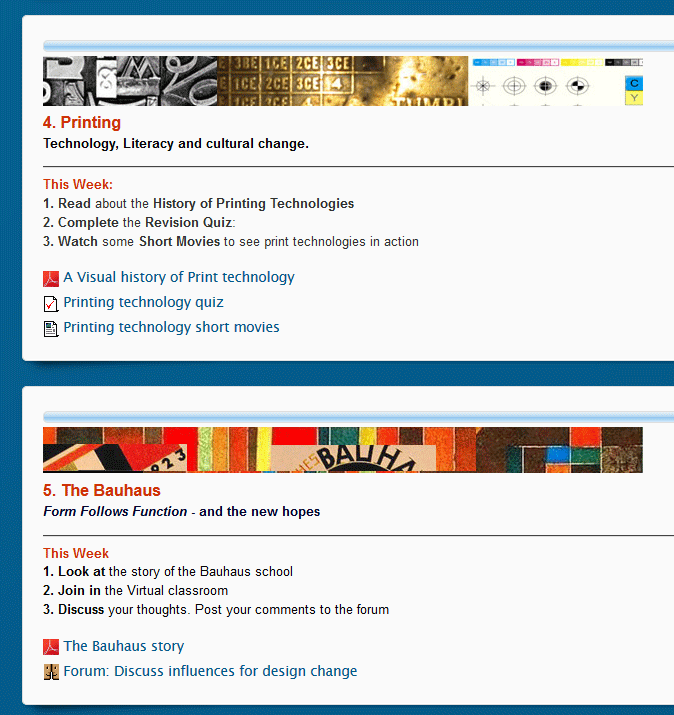Today is all about pinning down the most appropriate types of assessments for this subject. Yesterday I think I got a little caught up in reviewing the principles of good assessment – which was valuable but it might also be better applied to reviewing and refining the ideas that I come up with.
For what it’s worth, these are the notes that I jotted down yesterday that I want to bear in mind with these assessments. DDLR Assessment ideas
Looking over the four versions of this subject that my colleague J has run in the last 2 years has been particularly enlightening – even if I’m not entirely clear on some of the directions taken. The course design changed quite substantially between the second and third iterations – from a heavily class-based activity and assessment focus to more of a project based structure. (For convenience I’ll refer to the subjects as DDLR 1, 2, 3 and 4)
DDLR 1 and 2 provide an incredibly rich resource for learning to use eLearn (our Moodle installation) and each week is heavily structured and scaffolded to guide learners through the process of developing their online courses. The various elements of the units of competency are tightly mapped to corresponding activities and assessment tasks – moreso in DDLR 2. (Image from the DDLR subject guide)
I have to wonder however whether the course provides too much extra information – given the relatively narrow focus on designing and developing learning resources. Getting teachers (the learner cohort for this subject) to learn about creating quizzes and assignments in Moodle is certainly valuable but are these truly learning resources? This may well be one of the points where my approach to this subject diverges.
The shift in approach in DDLR 3 and DDLR 4 is dramatic. (As far as a diploma level course about designing learning resources might be considered dramatic, at least.) The assessments link far more closely to the units of competency and all save the first one are due at the end of the subject. They are far more formally structured – template based analysis of the target audience/learners, design documents, prototypes and finished learning resources, as well as a reflective journal.
It does concern me slightly that this subject has a markedly lower rate of assessment submission/completion that the two preceding ones. That said, this subject is often taken by teachers more interested in the content than in completing the units of competency and that may just have been the nature of this particular cohort.
This new assessment approach also seems far more manageable from a teaching/admin perspective than the previous ones, which required constant grading and checking.
My feeling is that this is a more sustainable approach but I will still look for ways to streamline the amount of work that is required to be submitted.
The next step was to map the various elements of competency to assessment items. The elements for both units of competency are written differently enough to need to be considered separately (unfortunately) but they both still broadly sit within the ADDIE (Analyse, Design, Develop, Implement, Evaluate) framework. ADDIE seems like a useful way to structure both the course and the assessments so I have mapped the elements to this. I have also highlighted particular elements that are more indicative of outputs that might be assessed. Working through the analysis process will be quite dry (and could potentially come across as slightly patronising) so finding an engaging approach to this will be important.

Finally, I had a few ideas come to me as I worked through this process today that I might just add without further comment.
DDLR / DDeLR ideas
Get the class to design and develop a (print based? ) checklist / questionnaire resource that might be used to address DDLR 1 and DDeLR 1 UoCs. Get someone else in the class to use it to complete their Analysis phase.
Can I provide a range of options for the forms the assessment/resource pieces might take?
Try to develop a comprehensive checklist that teachers can use on the resources that they produce to raise the quality overall of resources at CIT. (Again, this could be a student led tool – the benefit of this is that it makes them think much more about what a good resource requires – does this meet any UoCs??)
Convert the print based Analysis document into a web resource – book tool or checklist maybe? Also possibly fix the print based one first – from a deliberately badly designed faulty version. (Lets me cover some readability / usability concepts early)
How much of this subject is leading the learners by the hand? How much is about teaching them how to use eLearn tools?
Could one of the learning resources be about developing something that teaches people how to use a particular eLearn tool???
Need to identify what kinds of resources teachers can make. Good brainstorm activity in week 1.
Think about the difference between creating a learning resource and finding one and adding it to your course. (Still important but tied to the UoC?)
If I give teachers the option to use previously developed resources (authenticity issues??), they should still provide some kind of explanatory document AND/OR edit the resource and discuss what changes they made and why.
Need to consider the relative strengths and weaknesses of the various types of tools.
In-class feedback of learning resources to better support the evaluation and implementation based elements of competency.
One activity (possible assessment) could be for learners to gather information needed to do an analysis from a partner in the group. (and vice versa) Might lead to a more critical examination of what information is being sought. Learner might even provide suggestions for design/development?
Sample resources?

